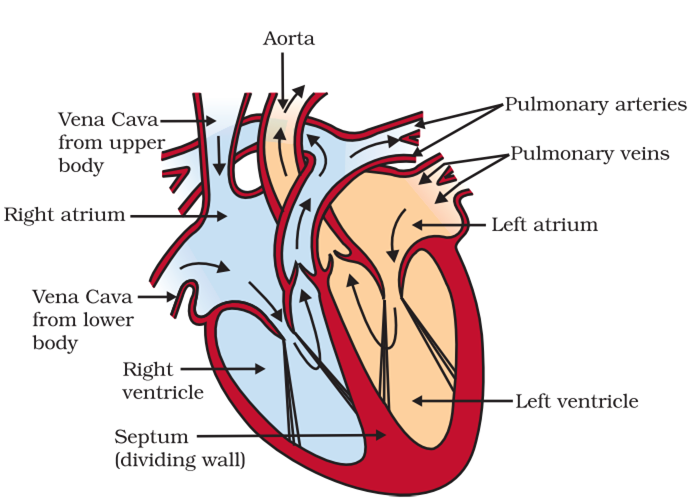CBSE
Class 10 Class 12
Human beings like other multicellular organism need a regular supply of food, oxygen etc. This function is performed by the circulatory system.
The circulatory system in human beings consists of:
The heart is a muscular organ. The heart is a pumping organ which pumps the blood. The human heart is composed of four chambers, viz. right auricle, right ventricle, left auricle and left ventricle.

Circulation of Blood through the heart:
Systemic Vein → Sinus Venosus → Right Auricle → Right Ventricle → Pulmonary Artery → Lungs → Pulmonary Vein → Left Auricle → Left Ventricle → Truncus Arteriosus → Systemic Circulation
Arteries are the vessels which carry blood away from the heart to various organs of the body.
The blood emerges from the heart under high pressure, the arteries have thick, elastic walls.
Veins collect the blood from different organs and bring it back to the heart. They do not need thick walls because the blood is no longer under pressure, instead, they have valves that ensure that the blood flows only in one direction.
Blood: Blood is a connective tissue which plays the role of the carrier for various substances in the body. Blood is composed of plasma, blood cells and platelets.
Blood Plasma: Blood plasma is a pale coloured liquid which is mostly composed of water. Blood plasma forms the matrix of blood.
Blood Cells: There are two types of blood cells, viz. Red Blood Cells (RBCs) and White Blood Cells(WBCs).
Red Blood Corpuscles (RBCs): These are of red colour because of the presence of haemoglobin which is a pigment. Haemoglobin readily combines with oxygen and carbon dioxide. The transport of oxygen happens through haemoglobin. Some part of carbon dioxide is also transported through haemoglobin.
White Blood Corpuscles (WBCs): These are of pale white colour. They play important role in the immunity.
Platelets: Platelets are responsible for blood coagulation. Blood coagulation is a defence mechanism which prevents excess loss of blood; in case of an injury.
Lymph: Lymph is similar to blood but RBCs are absent in lymph. Lymph is formed from the fluid which leaks from blood capillaries and goes to the intercellular spaces in the tissues. This fluid is collected through lymph vessels and finally returns to the blood capillaries. Lymph also plays an important role in the immune system.
Transpiration is the process of loss of water as vapour from aerial parts of the plant.
Function :
(a) Absorption and upward movement of water and minerals by creating PULL.
(b) Helps in temperature regulation in the plant.
Transport of food from leaves (food factory) to a different part of the plant is called Translocation.Plants have specialized vascular tissues for transportation of substances. There are two types of vascular tissues in plants, viz. xylem and phloem.
Xylem: Xylem is responsible for transportation of water and minerals. It is composed of tracheids, xylem vessels, xylem parenchyma and xylem fibre. Tracheids and xylem vessels are the conducting elements. The xylem makes a continuous tube in plants which runs from roots to stem and right up to the veins of leaves.
Phloem: Phloem is responsible for transportation of food. Phloem is composed of sieve tubes, companion cells, phloem parenchyma and bast fibres. Sieve tubes are the conducting elements
in phloem.
Xylem tissue, vessels and tracheids of the roots, stems and leaves are interconnected to form a continuous system of water-conducting channels reaching all parts of the plant. At the roots, cells in contact with the soil actively take up ions. This creates a difference in the concentration of these ions between the root and the soil.
Phloem transports food materials from the leaves to different parts of the plant body. The transportation of food in phloem is achieved by utilizing energy from ATP. As a result of this, the osmotic pressure in the tissue increases causing water to move into it. This pressure moves the material in the phloem to the tissues which have less pressure. This is helpful in moving materials according to the needs of the plant. For example, the food material, such as sucrose, is transported into the phloem tissue using ATP energy.